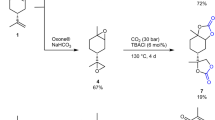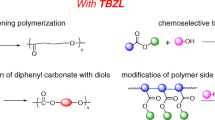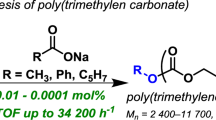Abstract
A series of complexes consisting of natural amino acids and tin (Sn(AA)2) prepared by conventional neutralization reactions were tested as a new class of cost-effective catalysts with high reactivity and low toxicity towards some biocompatible aliphatic polyesters. In our system, by using a simple catalyst and a benzyl alcohol (BnOH) initiator, biocompatible, and biodegradable aliphatic polyesters, such as poly(l-lactide), poly(ε-caprolactone), and poly(trimethylene carbonate), were well prepared. The results demonstrated that Sn(AA)2 catalysts, especially the phenylalanine-tin complex (Sn(L-Phe)2) (Mn, up to 194 kg/mol), were suitable for the synthesis of moderate and high-molecular weight poly(l-lactide), which exhibited good biocompatibility. Analysis of the backbone structure and end groups of low-molar-mass polymers by using MALDI-TOF mass spectra and 1H NMR spectroscopy suggested that the reaction proceeds by a dual activation mechanism. Given their low cost, simple preparation, high reactivity, and low toxicity, complexes consisting of natural amino acids and tin are promising for industrial-scale production of biocompatible aliphatic polyesters.
This is a preview of subscription content, access via your institution
Access options
Subscribe to this journal
Receive 12 print issues and online access
$259.00 per year
only $21.58 per issue
Buy this article
- Purchase on Springer Link
- Instant access to full article PDF
Prices may be subject to local taxes which are calculated during checkout





Similar content being viewed by others
References
Arcy R, Burke J, Tirelli N. Branched polyesters: preparative strategies and applications. Adv drug Deliv Rev. 2016;107:60–81.
Yu I, Acosta-Ramírez A, Mehrkhodavandi P. Mechanism of living lactide polymerization by dinuclear indium catalysts and its impact on isoselectivity. J Am Chem Soc. 2012;134:12758–73.
Hu T, Yang C, Lin S, Yu Q, Wang G. Biodegradable stents for coronary artery disease treatment: recent advances and future perspectives. Mater Sci Eng C. 2018;91:163–78.
Nottelet B, Darcos V, Coudane J. Aliphatic polyesters for medical imaging and theranostic applications. Eur J Pharm Biopharm. 2015;97:350–70.
Jérôme C, Lecomte P. Recent advances in the synthesis of aliphatic polyesters by ring-opening polymerization. Adv Drug Deliv Rev. 2008;60:1056–76.
Stjerndahl A, Wistrand AF, Albertsson AC. Industrial utilization of tin-initiated resorbable polymers: synthesis on a large scale with a low amount of initiator residue. Biomacromolecules. 2007;8:937–40.
Platel RH, Hodgson LM, Williams CK. Biocompatible initiators for lactide polymerization. Polym Rev. 2008;48:11–63.
Dusselier M, Van Wouwe P, Dewaele A, Jacobs PA, Sels BF. Shape-selective zeolite catalysis for bioplastics production. Science. 2015;349:78–80.
Bagh B, Broere DLJ, Sinha V, Kuijpers PF, Leest NPV, Bruin BD, et al. Catalytic synthesis of N-heterocycles via direct C(sp3)-H amination using an air-stable iron (III) species with a redox-active ligand. J Am Chem Soc. 2017;139:5117–24.
Nachtergael A, Coulembier O, Dubois P, Helvenstein M, Mespouille L. Organocatalysis paradigm revisited: are metal-free catalysts really harmless. Biomacromolecules. 2015;16:507–14.
Kricheldorf HR, Weidner SM. High molar mass cyclic poly(L-lactide) via ring-expansion polymerization with cyclic dibutyltin bisphenoxides. Eur Polym J. 2018;105:158–66.
Kricheldorf HR, Weidner SM. SnOct2-catalyzed syntheses of cyclic poly(l-lactide)s with catechol as low-toxic co-catalyst. J Polym Environ. 2019;27:2697–706.
Liang Y, Sui M, He M, Wei Z, Zhang W. A strategy of in situ catalysis and nucleation of biocompatible zinc salts of amino acids towards poly (l-lactide) with enhanced crystallization rate. Polymers. 2019;11:No.790.
Zhou ZH, Hou SY, Wan HL. Peroxomolybdate (VI)-citrate and-malate complex interconversions by pH-dependence. synthetic, structural and spectroscopic studies. Dalton Trans. 2004;9:1393–9.
Che P, Fang D, Zhang D, Feng J, Wang J, Hu N, et al. Hydrothermal synthesis and crystal structure of a new two-dimensional zinc citrate complex. J Coord Chem. 2005;58:1581–8.
Song P, Chen G, Wei Z, Chang Y, Zhang W, Liang J. Rapid crystallization of poly (L-lactic acid) induced by a nanoscaled zinc citrate complex as nucleating agent. Polymer. 2012;53:4300–9.
Wu Y, Chen W, Meng F, Wu Y, Chen W, Meng F, et al. Core-crosslinked pH-sensitive degradable micelles: a promising approach to resolve the extracellular stability versus intracellular drug release dilemma. J Controlled Release. 2012;164:338–45.
Jaiswal AK, Kadam SS, Soni VP, Bellare JR. Improved functionalization of electrospun PLLA/gelatin scaffold by alternate soaking method for bone tissue engineering. Appl Surf Sci. 2013;268:477–88.
Sheng SJ, Hu X, Wang F, Ma Y, Gu M. Mechanical and thermal property characterization of poly-L-lactide (PLLA) scaffold developed using pressure-controllable green foaming technology. Mater Sci Eng C. 2015;49:612–22.
Liu C, Liu C, Gao Y, Cheng F, Xiao G, Wang J, et al. Apatite formation on poly(aryl ether sulfone ketone) Surfaces by means of polydopamine layers functionalized with phosphonate groups. Adv Mater Interfaces. 2018;5:1800003.
Tang J, Kong B, Wu H, Xu M, Wang Y, Wang Y, et al. Carbon nanodots featuring efficient FRET for real-time monitoring of drug delivery and two-photon imaging. Adv Mater. 2013;25:6569–74.
Pascual A, Sardon H, Veloso A, Ruiperez F, Mecerreyes D. Organocatalyzed synthesis of aliphatic polyesters from ethylene brassylate: a cheap and renewable macrolactone. ACS Macro Lett. 2014;3:849–53.
Kremer AB, Mehrkhodavandi P. Dinuclear catalysts for the ring opening polymerization of lactide. Coord Chem Rev. 2019;380:35–57.
Saito T, Aizawa Y, Yamamoto T, Tajima K, Isono T, Satoh T. Alkali metal carboxylate as an efficient and simple catalyst for ring-opening polymerization of cyclic esters. Macromolecules. 2018;51:689–96.
Chisholm MH, Patmore NJ, Zhou Z. Concerning the relative importance of enantiomorphic site vs. chain end control in the stereoselective polymerization of lactides: reactions of (R, R-salen)-and (S, S-salen)-aluminium alkoxides LAlOCH2 R complexes (R=CH3 and S-CHMeCl). Chem Commun. 2005;127–9.
Xu FJ, Wang ZH, Yang WT. Surface functionalization of polycaprolactone films via surface-initiated atom transfer radical polymerization for covalently coupling cell-adhesive biomolecules. Biomaterials. 2010;31:3139–47.
Li J, Zhang X, Zhao M, Wu L, Luo K, Pu Y, et al. Tumor-pH-sensitive PLLA-based microsphere with acid cleavable acetal bonds on the backbone for efficient localized chemotherapy. Biomacromolecules. 2018;19:3140–8.
Bian Y, Wei Z, Wang Z, Tu Z, Zheng L, Wang W, et al. Development of biodegradable polyesters based on a hydroxylated coumarin initiator towards fluorescent visible paclitaxel-loaded microspheres. J Mater Chem B. 2019;7:2261–76.
Acknowledgements
This work was financially supported by the Fundamental Research Funds for the Central Universities (No. DUT19LAB27).
Author information
Authors and Affiliations
Corresponding authors
Ethics declarations
Conflict of interest
The authors declare that they have no conflict of interest.
Additional information
Publisher’s note Springer Nature remains neutral with regard to jurisdictional claims in published maps and institutional affiliations.
Supplementary information
Rights and permissions
About this article
Cite this article
He, M., Cheng, Y., Liang, Y. et al. Amino acid complexes with tin as a new class of catalysts with high reactivity and low toxicity towards biocompatible aliphatic polyesters. Polym J 52, 567–574 (2020). https://doi.org/10.1038/s41428-020-0314-0
Received:
Revised:
Accepted:
Published:
Issue Date:
DOI: https://doi.org/10.1038/s41428-020-0314-0



